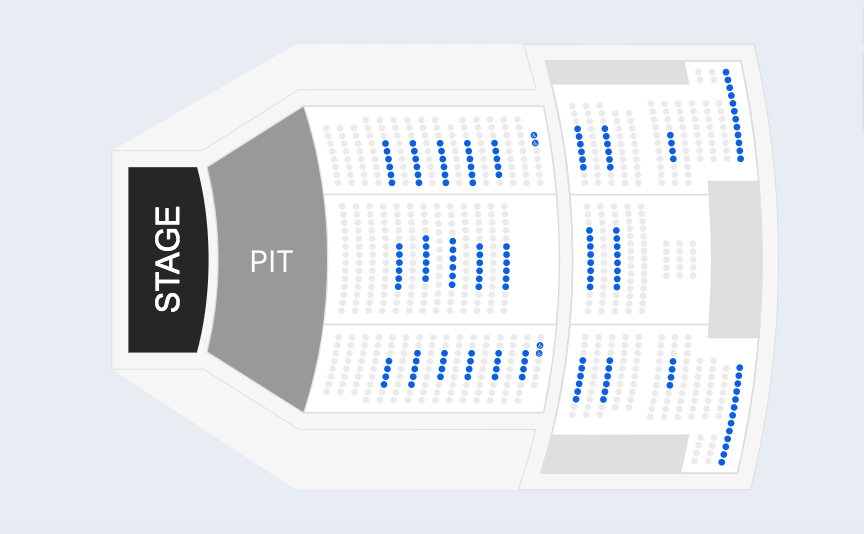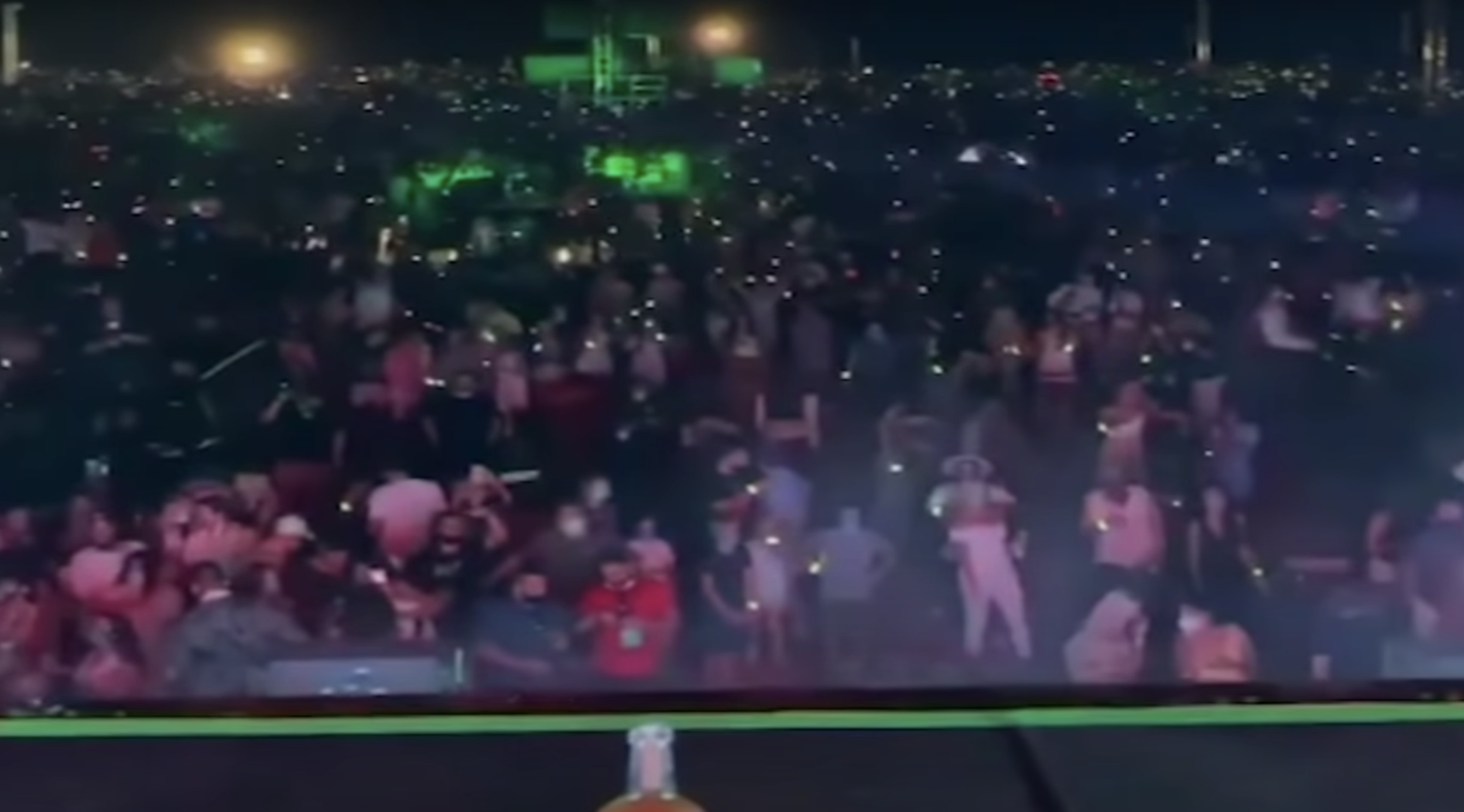Are Fan Pods the Future of Concerts?

TicketMaster’s ticket map for Travis McCready at TempleLive in Ft. Smith, Arkansas
The rooms themselves will likely determine how and when many will open.
On Friday, May 15, country rocker Travis McCready of Bishop Gunn will play a concert in Fort Smith, Arkansas. Set aside the wisdom of playing a concert in the midst of playing a concert during a pandemic; the concert is interesting as it gives us a look at a possible future for the remainder of 2020, 2021, and possibly 2022.
For the show, the TempleLive venue cut its seating capacity from 1,100 to 229—down 80 percent—and is selling the seats in “fan pods,” grouped tickets that much be purchased together, with each pod at least six feet from another. Attendees will be temperature-checked on the way in, and they must be masked. Those who don’t have masks will have to buy one at the door. The building will be sanitized before the show, and the walkways will all be one way. Bathrooms will have a 10-person capacity with touch-free soap and towel dispensers.
Some of these measures are probable in any vision of the future of live music, as well as many parts of our commercial lives. Temperature checks and masks as conditions of entry seem probable, armed maniacs in Michigan and Oklahoma aside. Touch-free bathrooms will likely become the standard as well. Venues will have to figure out seat spacing, and this “fan pod” concept is certainly one way.
As much as we’d like programmatic, across-the-board solutions, the reality is that the physical nature of each venue will affect its ability to open. One way corridors are a venue-specific solution that wouldn’t work in all spaces, but presumably it will in TempleLive. In New Orleans, patrons already enter Gasa Gasa at one end and leave at the other, but it will likely have to cut its capacity to 20 or 25 people if it wants to maintain six feet between them. It’s hard to imagine how a room as small as The Spotted Cat can open at all in a safe, socially distanced way, whereas The Howlin’ Wolf, with its wide entrance, long bar, and spacious floor, looks like a room that could be adapted to the circumstances.
At the McCready concert, tickets are $20 each, a price that likely reflects McCready’s market value, the challenge of getting people into a concert hall when it’s not clear that anyone should be at a concert, and the challenge of finding buyers who want six or more tickets. It’s a price and a show that look more like a test of a concept than a true, market-driven concert.
One specter that the McCready show raises is that concert tickets will become luxury items. The best seats at any arena concert, stadium concert and festival already are, but scarcity as well as the financial needs of the artists and venues could easily drive up the price of tickets. Michael Dorf, the founder of The City Winery venue in New York City, indirectly addressed this possibility in a guest editorial that he wrote for Pollstar when he advocated “a new spirit of cooperation” to hasten the return of live music.
“[P]ayouts to artists need to remain flexible until we are in a more stable period of ‘new normal,’” he wrote. “Smaller audiences will mean lower food and beverage sales. Lower revenues for venues will mean lower rent. Which means landlords will need to recalibrate their expectations and renegotiate lease terms. Developers, Real Estate Investment Trusts (REITS) and banks all need to recalibrate their idea of acceptable return-on-investment and profit levels. Clubs like mine may have to give up earning profits for the rest of 2020 and even 2021, but still put on shows for the benefit of our staff, the audience and the artists.”
Dorf is not necessarily the best messenger for that message as someone whose venue already treats live music as a luxury item. He also wrote in the editorial, “I published my first book, Indulge Your Senses, to advance the thesis that our culture’s overdosing on screens and gadgets has deepened our need for social gatherings and sensory experience. That philosophy drove my business plan to stage concerts in an intimate, 300-seat setting with close-up views of the artists, state-of-the-art acoustics, and the delicious aroma of food and wine made right on the premises, creating a magical experience that can’t be replicated with ones and zeros.”
Dorf’s analysis assumes a level of financial privilege that many New Orleans artists, venue owners, and fans don’t have. The musicians are playing to pay their mortgage and bills, so there are limits as to how cooperative they can be. The venues are likely in a similar situation. Dayna Frank, board president for the National Independent Venue Association, explained the financial realities of running independent music clubs to Rolling Stone’s Amy X. Wang:
We are in a low-margin business just like the restaurants, but it is a high-liability business and capital-intensive business. We have massive spaces of retail—giant storefronts and high rents. We are located in popular neighborhoods and most of our members are in expensive districts. We still have to carry insurance, because we know that when the economy gets bad, people get more litigious. We are still rearranging shows and trying to return product, but most people are carrying full health insurance benefits for furloughed employees and we still have HVAC repairs, capital improvements, debt obligations. We have sales tax, property taxes. And we have zero cash flow.
That doesn’t mean Dorf’s wrong, though. The question is how far that spirit of cooperation will extend and how flexible everybody can be. There’s no question. It’s in the musician, the club owner, and the club’s landlord’s best interest to make it possible for everybody to earn something and stay economically afloat—if only just barely—until treatments, vaccines, or other developments allow us to return to as close as possible to a pre-COVID-19 normal. But will the financial needs of the parties involved allow them to make decisions that work for everybody including the fans? Or, will the 25 or 250 fans have to pay dearly for the privilege to be in the room? Then again, with so many people out of work, will there be people to pay higher ticket prices?
And what will a live music scene look like? Indie bands rely on live shows and touring to make money and make people aware of their new music. Steve Wynn of The Dream Syndicate and The Baseball Project has been touring since the early 1980s, but he told Jim Sullivan of WBUR that he’s reluctant to hit the road under these conditions.
“Stages, house crews, vans, hotels, gas stations, bars, liquor bottles and shot glasses backstage—how easy will it be to make any of those things be considered safe until we have a cure or a guaranteed treatment?” he asked. “I know it’s a logistical nightmare and a financial hit for many bands and agents out there. I’m nothing if not optimistic and resourceful by nature and I'd love to be optimistic, but it might be longer than we'd like to think.”
Creator of My Spilt Milk and its spin-off Christmas music website and podcast, TwelveSongsOfChristmas.com.






